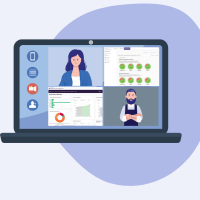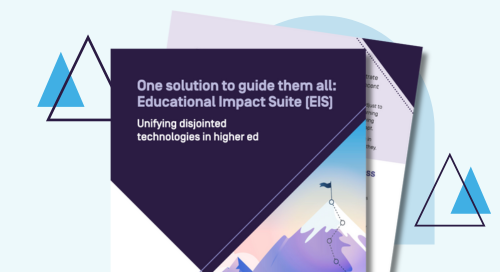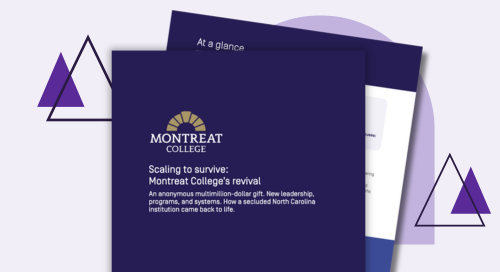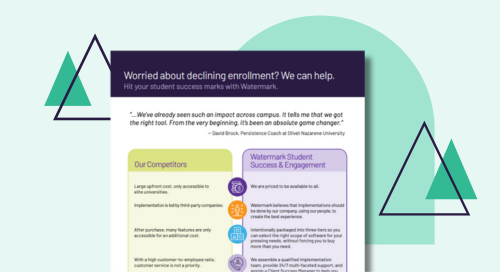The essential guide to faculty qualifications
There’s a hot topic on campus: faculty qualifications, or what accrediting bodies often call credentialing. While the vast majority of faculty are qualified to teach based on their academic degrees, some faculty (particularly adjuncts or those in health sciences or business) may be qualified based on work experience, licenses, certifications, or other qualifying activities.
Here’s what you need to know about credentialing, from what accrediting bodies mean by it to approaches for documenting and defending your faculty’s qualifications.
All of the institutional accrediting bodies — formerly referred to as regional accrediting bodies — speak to the concept of a “qualified” faculty. Some accreditors provide detailed explanations of what constitutes a qualified professional while others are more vague. Accrediting bodies vary in how detailed they want institutions to be as they document and report faculty credentials. For some institutional and programmatic accrediting bodies, a list of faculty and their terminal degrees may be sufficient, while others require much more detail. The Southern Association of Colleges and Schools Commission on Colleges (SACSCOC) is generally viewed as the most detailed in its specified requirements, and the Higher Learning Commission (HLC) has also provided a great deal of guidance on the guidelines for faculty credentialing.
Qualifications, then and now
Historically, the primary way for a faculty member to be considered qualified has been an academic credential (i.e., you are qualified to teach molecular biology because you have a PhD. in that field). However, in a changing world, more and more institutions and the bodies that accredit them are recognizing that experience, research, and other types of training can be just as compelling and rigorous a reason as a formal credential.
While the majority of your faculty are likely still qualified based on their terminal degrees, as these other justifications and experiences come into play, it becomes vital that institutions create appropriate policies, processes, and documentation of how they determine appropriate qualifications for their teaching faculty.


Institutional accreditor |
Qualification standard |
| Higher Learning Commission (HLC) | 3.C. Sufficiency of Faculty and Staff. The institution has the faculty and staff needed for effective, high-quality programs and student services. |
| New England Commission of Higher Education (NECHE) | 6.3 The preparation and qualifications of all faculty and academic staff are appropriate to the nature of their assignments. Qualifications are measured by advanced degrees held, evidence of scholarship, advanced study, creative activities, and teaching abilities, as well as relevant professional experience, training, and credentials. |
| Middle States Commission on Higher Education (MSCHE) |
3.2.B. An accredited institution possesses and demonstrates student learning experiences that are designed, delivered, and assessed by faculty (full-time or part-time) and/or other appropriate professionals who are qualified for the positions they hold and the work they do. |
| Southern Association of Colleges and Schools Commission on Colleges (SACSCOC) |
6.2.A. For each of its educational programs, the institution justifies and documents the qualifications of its faculty members. |
| WASC Senior College and University Commission (WSCUC) | CFR 3.1 The institution employs faculty, staff, and administrators sufficient in scale, professional qualifications, and background to achieve the institution’s educational and student success objectives, to propose and oversee policy, and to ensure the integrity of its academic, student support, and co-curricular programs and services and administrative processes. |
| Northwest Commission on Colleges and Universities (NWCCU) | 2.F.3 Consistent with its mission, programs, and services, the institution employs faculty, staff, and administrators sufficient in role, number, and qualifications to achieve its organizational responsibilities, educational objectives, establish and oversee academic policies, and ensure the integrity and continuity of its academic programs. |
Given the range of expectations from institutional accrediting bodies, plus the requirements of programmatic accreditors, is it better to take a high-level, overview approach, or get into the details of individual courses? We’ve worked with institutions across regions to develop a framework for credentialing that should allow you to provide the qualification information needed to satisfy any accreditor.
“We’ve been using Faculty Success for over 10 years — it’s a workhorse for us. It reaches all parts of faculty life. Outreach and engagement reporting, annual faculty reviews, reporting scholarly productivity for graduate students, it all happens inside Faculty Success.”
— Jennifer Hughes, Managing Director of the Office of Planning and Assessment, Texas Tech University
Credentialing framework advisors
Institutions like yours from across accrediting regions have reviewed and confirmed that this framework allows them to satisfy their accrediting body.
This approach is easier, but less detailed. You’ll document faculty’s education, licenses, certification, and scheduled teaching, then provide a method to capture “additional qualifications,” such as a text box. The additional information is then available in a consistent format for use in reporting. This information is then reviewed by someone from the Office of Accreditation, the dean’s office, or a peer reviewer, who can determine if they align.
Course-level approach
This approach requires significant upfront work to populate the information, plus ongoing work to maintain your dataset.
To use the course-level approach, you’ll need:
- Qualification categories.
- Selections for specific degrees, licenses/certifications, and work history.
- A place for additional text and files to support the qualification.
- A method for connecting qualifications to relevant courses.
“I oversee a lot of our accreditation efforts. Being able to integrate with our student information system (SIS) — which is Banner for us — to bring all scheduled teaching in, to then produce that faculty roster for SACSCOC accreditation work. It saved me weeks, if not months, of time, of manual activity — it was truly a game changer for our entire process. It freed me up to focus on some of the other things that really matter, in doing this good accreditation work, rather than the sort of grind of pulling together a report, a document, which was generated in seconds from Faculty Success.”
— Kyle Christmas, Executive Director of Accreditation and External Compliance, Austin Peay State University
Whether you take the basic or course-level approach, you’ll need to define your internal process for determining qualifications. It is important to identify who at your institution is responsible for reviewing and updating this information. At some institutions this may be a single person in an Office of Accreditation, while at others, deans or department chairs may be responsible. No matter how you assign this responsibility, you will want to have a single person who can help ensure the information is being correctly entered and kept up to date.
Addressing these questions is essential. If you don’t have a well-defined process or it isn’t sustainable, it won’t live up to the requirements of peer reviewers from your institutional accreditor.
It takes a good deal of effort to capture and maintain the information needed for course-level credentialing, so here are some factors to consider when deciding.
If your institution falls into one of these categories, consider course-level credentialing:
- You don’t currently have a clearly documented process.
- You’re in the SACSCOC region.
- You’re a for-profit institution.
- You have a very large adjunct population.
As course-level credentialing is a significant undertaking, you will need to have someone dedicated to the initial input of the information. Additionally, you will need to have someone to maintain the credentialing information on an ongoing basis (i.e., review and update each term/semester).
All others should consider taking the basic approach.
The basic approach is a good choice if:
- A large majority of your faculty are qualified solely based on their highest degree.
- You have a well-defined process to evaluate qualifications for the few faculty who aren’t qualified based on their academic credential.
We’re here to help
The way your institution documents faculty qualifications will depend on the level of detail needed to satisfy accreditors and other stakeholders. Contact us today so we can discuss your credentialing needs.
Learn about other ways Watermark supports your accreditation journey.
The Classification of Instructional Programs (CIP) provides a taxonomic scheme that supports the accurate tracking and reporting of fields of study and program completions activity. CIP was originally developed by the U.S. Department of Education’s National Center for Education Statistics in 1980. For example, “Anatomy” has the six digit code of 26.0403, which places it in “Cell/Cellular Biology and Anatomical Sciences (26.04) and “Biological and Biomedical Sciences” (two-digit CIP 26).
Some institutions may wish to use this classification as a way to easily match faculty academic degrees with the courses they are teaching. While this may be possible, consider the following cautions:
- If you choose to use CIP codes, you have committed to course-level credentialing.
- CIP codes aren’t included in transcripts, so you may not have or know the CIP codes that should be associated with a faculty member’s degrees. You’ll have to make that determination based on coursework, program name, etc.
- Many courses and programs don’t fit neatly into a single CIP code. The level of granularity in the CIP code often results in an “it might be this or it might be that” decision that could raise flags rather than resolving them.
- Even if you use CIP codes, there would still be a need to account for “other qualifications” and be able to associate those qualifications with specific courses.
All of the potential issues noted here may add to confusion for faculty, administrators, and peer reviewers rather than reduce it. Although CIP codes are widely used for education surveys and statistics, they aren’t generally known or used outside of the Registrar’s Office and Institutional Research Office. In general, while utilizing CIP codes in this way may give you a good “start” to your documentation and process needs or provide an excellent backup, they won’t solve the problem of how to account for non-degree qualifications and they aren’t a guaranteed solution.
About Watermark
Watermark gives higher education institutions the tools they need to easily track, manage, and examine their data. For over 20 years, colleges and universities have used Watermark solutions to complete assessment and accreditation requirements, capture and analyze student feedback, showcase faculty accomplishments, and improve student engagement. Watermark’s Educational Impact Suite (EIS) puts data into context so faculty and staff can focus on what matters most: institutional and student success. Learn why Watermark is trusted by over 1,700 colleges and universities to support continuous improvement at www.watermarkinsights.com.

Browse our resource library
See how our tools are helping clients right now, get in-depth information on topics that matter, and stay up-to-date on trends in higher ed.










